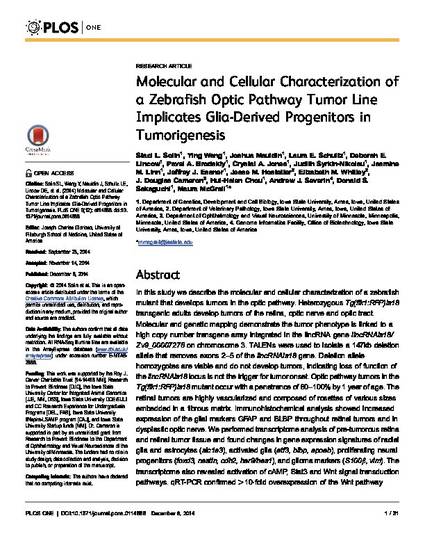
In this study we describe the molecular and cellular characterization of a zebrafish mutant that develops tumors in the optic pathway. Heterozygous Tg(flk1:RFP)is18 transgenic adults develop tumors of the retina, optic nerve and optic tract. Molecular and genetic mapping demonstrate the tumor phenotype is linked to a high copy number transgene array integrated in the lincRNA gene lincRNAis18/Zv9_00007276 on chromosome 3. TALENs were used to isolate a 147kb deletion allele that removes exons 2–5 of the lincRNAis18 gene. Deletion allele homozygotes are viable and do not develop tumors, indicating loss of function of thelincRNAis18 locus is not the trigger for tumor onset. Optic pathway tumors in theTg(flk1:RFP)is18 mutant occur with a penetrance of 80–100% by 1 year of age. The retinal tumors are highly vascularized and composed of rosettes of various sizes embedded in a fibrous matrix. Immunohistochemical analysis showed increased expression of the glial markers GFAP and BLBP throughout retinal tumors and in dysplastic optic nerve. We performed transcriptome analysis of pre-tumorous retina and retinal tumor tissue and found changes in gene expression signatures of radial glia and astrocytes (slc1a3), activated glia (atf3, blbp, apoeb), proliferating neural progenitors (foxd3, nestin, cdh2, her9/hes1), and glioma markers (S100β, vim). The transcriptome also revealed activation of cAMP, Stat3 and Wnt signal transduction pathways. qRT-PCR confirmed >10-fold overexpression of the Wnt pathway components hbegfa, ascl1a, and insm1a. Together the data indicate Müller glia and/or astrocyte-derived progenitors could contribute to the zebrafish Tg(flk1:RFP)is18 optic pathway tumors.
Available at: http://works.bepress.com/andrew-severin/8/

This article is from PLoS One 9 (2014): e114888, doi:10.1371/journal.pone.0114888. Posted with permission.